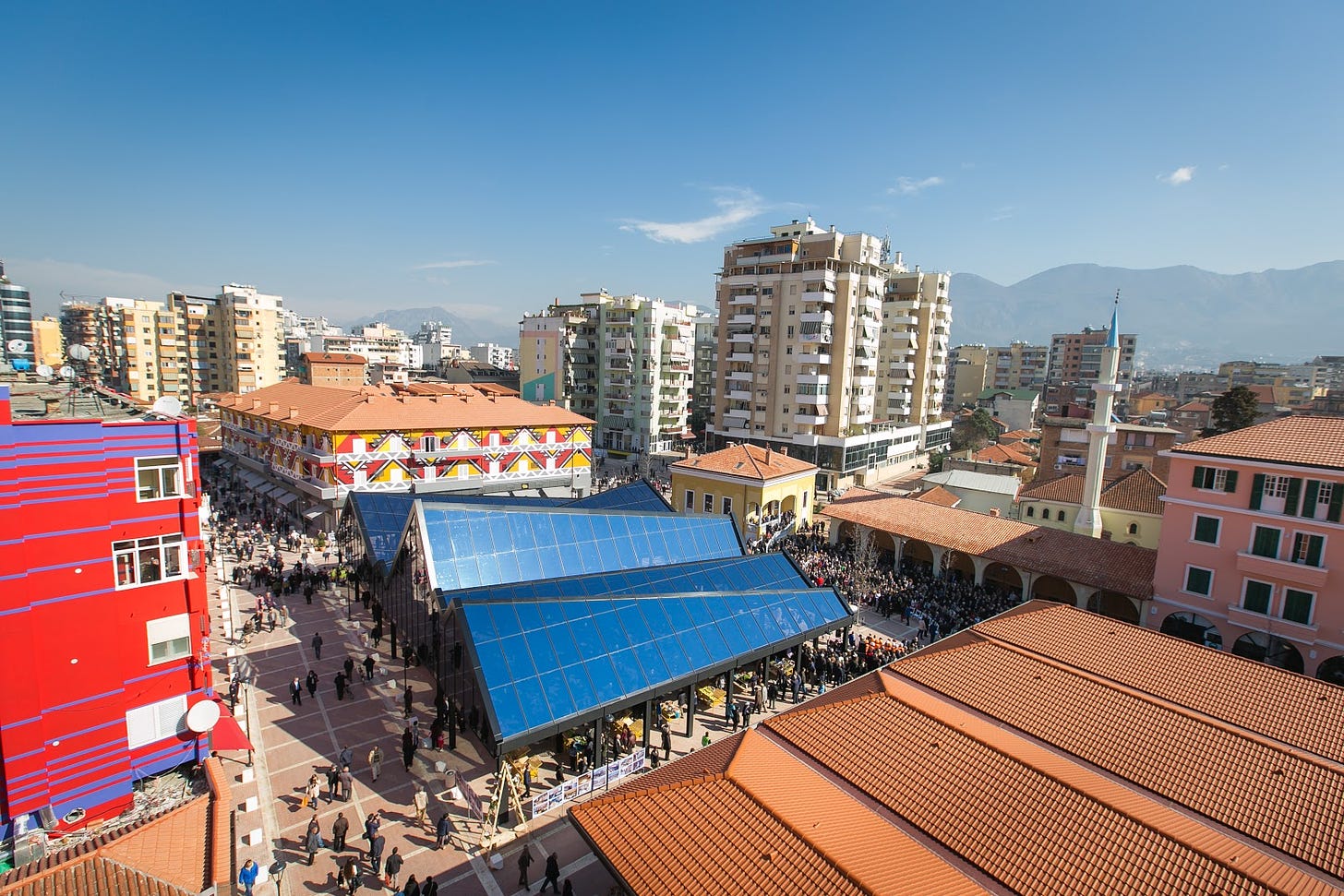Happy New Year! 🎄
The first issue of this two-part series on financial instruments in development and planning went over development charges, conditioned construction density, value-based property taxes and tax increment financing. This week I go over business/tourism improvement districts, public private partnerships, special assessment districts, betterment fees and municipal development authorities. Some basic examples tap on my personal experience in providing relevant case studies from Tirana. If you have questions or want to know more do not hesitate to contact me.
BUSINESS & TOURISM IMPROVEMENT DISTRICTS
Business Improvement Districts (BIDs) or Tourism Improvement Districts (TIDs) provide a common management framework and supply additional maintenance services to existing municipal services. Owners of businesses in designated areas sometimes pay extra charges or fees to the local authority. These extra revenues are collected into a dedicated fund and are used exclusively to maintain and improve the district. Typically if a majority of businesses in a designated area agree to a BID, then all businesses will be required to pay the new charge. BIDs and TIDs are usually managed by a special purpose NGO led by representatives of the business owners and the local authority.
Tirana Case Study
The New Bazaar in Tirana was financed by the Local Authority in collaboration with a Private Development Foundation grant with each contributing 50% of the total investment of six million Euros. The city set up a Tourism Improvement District for the new Bazaar with a board composed of business owners, local authority staff and representatives from the grant-giving foundation. All the revenues collected by the local authority within the bounds of the business improvement district including business rates and property tax are transferred to the board which manages and invests them as it sees fit. The city still provides all typical services to the district, with the extra revenues serving for management, investment, repair and activation. The scheme has not only seen a surge in the business rates paid to the city, but at the same time has incentivized more than four million Euros of private capital which has been invested in improving establishments and businesses by their owners.
PUBLIC-PRIVATE PARTNERSHIPS
Public Private Partnerships (PPPs) can be employed in funding co-operative projects between private developers and public entities. They are often employed in countries that have limited borrowing ability and therefore can extend their capital expenditure capacities by tapping collaboration with the private sector. PPPs can take different forms depending on the type of project and public interest involved including build-operate-transfer models, joint-investment models or private investment joint-ownership models.
Tirana Case Study
The New National Stadium of Tirana was built with a private investment joint-ownership model. The old stadium was public owned and administered by of the National Football Federation. The Federation through a competitive bidding process selected a private developer as a partner in the New Stadium Development. As part of the final stipulations the Private Developer would build a new UEFA Category-4 Stadium, office space for the national football federation as well as all of the mandatory amenities for such a structure. In return the developer would be allowed to build and own 5-star hotel tower within the property boundary of the stadium. The successful project was completed in less than three years with the developer bearing the full costs of the investment: ultimately the public domain earned a brand new structure as well as adjacent public spaces with zero direct financial costs.
BETTERMENT FEE
Betterment fees are assessed on property-owners benefiting from public capital expenditures in infrastructure or land use changes. The logic behind betterment fees is that the value generated by local government decisions should be at least partially captured in favor of public interest. Betterment fees’ crucial difference to development charges is that they are assessed as a fraction of the change in value brought about by the public investment.
SPECIAL ASSESSMENT DISTRICT
Special Assessment Districts (SADs) proportionally discharge the cost of a public improvement to the district’s property-owners. This instrument is similar to BIDs in that if more than half of landowners in a certain area desire a certain public improvement, they can work with the municipality to designate a SAD. All landowners will then be charged a special assessment for a set amount of time. This extra charge will repay the costs incurred by the municipality in implementing the infrastructure or public amenity.
MUNICIPAL DEVELOPMENT AUTHORITIES
Municipal Development Authorities (MDAs) are public corporations that promote, coordinate and manage development for designated areas of the city. MDAs can capitalize on the municipal monopoly on planning: they can be extremely efficient value capture tools in greenfield development or peripheral development projects which include urbanizing previously agricultural or natural land. MDAs could purchase properties at the agricultural land-use value, change the land-use in coordination with the municipality and resell the land to private developers at considerable profit margins. The combination of low-cost land acquisition and strong plan-making powers could easily reduce speculation and disincentivize rent-seeking behavior in the housing market. MDAs can also be especially valuable in combination with transportation projects, by capitalizing on the increased value of land and expanded development opportunities on new transportation hubs.
Did you like this issue of thinkthinkthink? Consider sharing it with your network: Share
📚 One Book
Making the Modern World by Vaclav Smil
Smil has a way with numbers. This book felt like reading an extremely interesting dictionary - cover-to-cover. I could barely contain the cognitive dissonance of absorbing a mostly bland, number-heavy recent history of technology, while at the same time being totally glued to the minutiae of carbon vs hydrogen energy potential in methane. It’s the definitive history of global material flows, a book one might refer to often.
🔗 Three Links
What the Hole Is Going On? The bucatini shortage of 2020 by Rachel Handler\ The bucatini investigation that has captured the world’s attention.
FSB Officer Inadvertently Confesses Murder Plot to Navalny by Bellingcat\ An absurd but impossible not to believe first person account of attempted murder.
Why Markets Boomed in a Year of Human Misery by Neil Irwin and Weiyi Cai\ On 2020: markets & misery
🐤 Five Tweets
The unusual barrel-shaped eyes of Macropinna microstoma can rotate inside the transparent shield that covers the fish's head. This allows the fish to see through its transparent head and notice potential prey that may come from different flanks. #MLP #fish #curiosities pic.twitter.com/u68WAcNzWB
— Marine Life Project (@MarineLifeProj) January 29, 2019
Did you know Monopoly was invented by a woman named Elizabeth Magie in 1903? She created board games to express her political beliefs.
— Sheril Kirshenbaum (@Sheril_) December 27, 2020
Originally called ‘The Landlord’s Game,’ it was designed as a protest against the big monopolists of her time like Carnegie & Rockefeller. 1/ pic.twitter.com/1Ii55Muhjj
It needs to be approached like fire prevention, from the community up. Every town and township has a fire crew or a volunteer fire crew, and that’s why whole cities don’t burn down anymore.
— Mathieu Hélie (@mathieuhelie) January 1, 2021
Here is a prime example from today to Israel "organized chaos". End of the day in a vaccine center. A few doses left and will expire. Nurses go out, spot a pizza delivery guy, call him "pizza guy wanna vaccine?", jab, and another person has spike mRNA!https://t.co/cBkPqPz46W
— Yaniv Erlich (@erlichya) December 31, 2020
It's impressive how @BostonDynamics has just skipped through the uncanny valley & into the future. I would totally pay to watch the live performance reincarnation of this video.https://t.co/Gcu1GbUuuj
— Joni Baboci (@dbaboci) December 30, 2020
This was the sixteenth issue of thinkthinkthink - a periodic newsletter by Joni Baboci on cities, science and complexity. If you really liked it why not subscribe?



